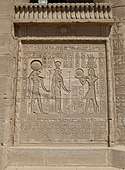Dendera Temple complex
Dendera Temple complex (Ancient Egyptian: Iunet or Tantere; the 19th-century English spelling in most sources, including Belzoni, was Tentyra; also spelled Denderah[1]) is located about 2.5 kilometres (1.6 mi) south-east of Dendera, Egypt. It is one of the best-preserved temple complexes in Egypt. The area was used as the sixth nome of Upper Egypt, south of Abydos.
Description
The whole complex covers some 40,000 square meters and is surrounded by a hefty mudbrick enclosed wall. Dendera was inhabited in prehistory, a useful oasis on the banks of the Nile. It seems that pharaoh Pepi I (ca. 2250 BC) built on this site and evidence exists of a temple in the Eighteenth Dynasty (ca 1500 BC). The earliest extant building in the compound today is the mammisi raised by Nectanebo II – last of the native pharaohs (360–343 BC). The features in the complex include:
- Hathor temple (the main temple)
- Temple of the birth of Isis
- Sacred Lake
- Sanatorium
- Mammisi of Nectanebo II
- Christian Basilica
- Roman Mammisi
- a Barque shrine
- Gateways of Domitian and Trajan
- the Roman Kiosk
Nearby is the Dendera necropolis, a series of mastaba tombs. The necropolis dates from the Early Dynastic Period of the Old Kingdom to the First Intermediate Period of Egypt.[2] The necropolis runs the eastern edge of the western hill and over the northern plain.
Hathor temple
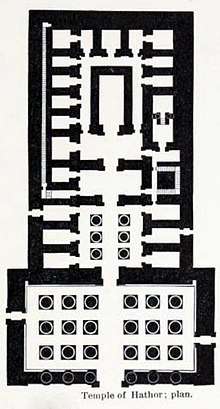
The dominant building in the complex is the Temple of Hathor. The temple has been modified on the same site starting as far back as the Middle Kingdom, and continuing right up until the time of the Roman emperor Trajan.[2] The existing structure began construction in the late Ptolemaic period at the time of Ptolemy Auletes in July 54 BCE.[6][7] and the hypostyle hall was built in the Roman period under Tiberius.[8]
In Egypt, Trajan was quite active in constructing buildings and decorating them. He appears, together with Domitian, in offering scenes on the propylon of the Temple of Hathor. His cartouche also appears in the column shafts of the Temple of Khnum at Esna.[5]
Layout elements of the temple are:
- Large Hypostyle Hall
- Small Hypostyle Hall
- Laboratory
- Storage magazine
- Offering entry
- Treasury
- Exit to well
- Access to stairwell
- Offering hall
- Hall of the Ennead
- Great Seat and main sanctuary
- Shrine of the Nome of Dendera
- Shrine of Isis
- Shrine of Sokar
- Shrine of Harsomtus
- Shrine of Hathor's Sistrum
- Shrine of gods of Lower Egypt
- Shrine of Hathor
- Shrine of the throne of Rê
- Shrine of Rê
- Shrine of Menat collar
- Shrine of Ihy
- The Pure Place
- Court of the First Feast
- Passage
- Staircase to roof
Depictions of Cleopatra VI which appear on temple walls are good examples of Ptolemaic Egyptian art.[9] On the rear of the temple exterior is a carving of Cleopatra VII Philopator (the popularly well known Cleopatra) and her son, Ptolemy XV Philopator Philometor Caesar (Caesarion), who was fathered by Julius Caesar.[10]
Dendera zodiac
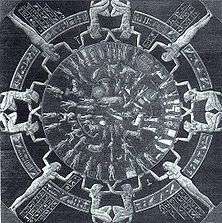
The sculptured Dendera zodiac (or Denderah zodiac) is a widely known relief found in a late Greco-Roman temple, containing images of Taurus (the bull) and the Libra (the balance). A sketch was made of it during the Napoleonic campaign in Egypt. In 1820 it was removed from the temple ceiling by French colonizers and replaced with a fake. There is controversy as to whether they were granted permission by Egypt's ruler, Muhammad Ali Pasha, to do so, or whether they stole it. The real one is now in the Louvre.[11] Champollion's guess that it was Ptolemaic proved to be correct, and Egyptologists now date it to the first century BC.[12]
Crypts
The subterranean Hathor temple tombs total twelve chambers. Some reliefs are dated to as late as the reign of Ptolemy XII Auletes. The crypts reportedly were used for storing vessels and divine iconography. An opening in the "Flame Room" floor leads to a narrow chamber with representations on the walls of the objects which were kept in them. In the second chamber, a relief depicts Pepi I offering a statuette of the god Ihy to four images of Hathor. In the crypt, reached from the "throne room", Ptolemy XII has jewelry and offerings for the gods.
The Dendera light
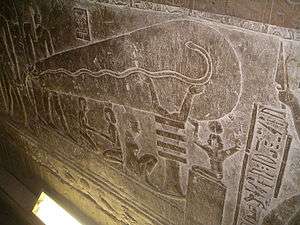
The Hathor Temple has a relief sometimes known as the Dendera light because of a controversial fringe thesis about its nature. The Dendera light images comprise five stone reliefs (two of which contain a pair of what fringe authors refer to as lights) in the Hathor temple at the Dendera Temple complex located in Egypt. The view of Egyptologists is that the relief is a mythological depiction of a djed pillar and a lotus flower, spawning a snake within, representing aspects of Egyptian mythology.[13][14]
In contrast to this interpretation, there is a fringe science suggestion that it is actually a representation of an Ancient Egyptian lightbulb.[15]
Ceiling cleaning
The ceiling of the Hathor Temple was cleaned in a careful way that removed hundreds of years of black soot without harming the ancient paint underneath. Spectacular ceiling painting was exposed in the main hall, and some of the most vibrant and colourful paintings dating from antiquity are now visible.
Roman mammisi
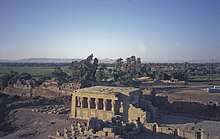
The Roman mammisi id a subsidiary building dating to the reigns of Trajan and Marcus Aurelius. Numerous reliefs of Trajan making offerings to Egyptian deities can be seen.[6]
Tourism
The Dendera complex has long been one of the most tourist-accessible ancient Egyptian places of worship. It used to be possible to visit virtually every part of the complex, from the crypts to the roof. However, the highest part of the roof of Hathor temple has been closed since 2003. The second stage of the roof was closed in November 2004, after a tourist got too close to the edge and fell to her death on the bedrock below.
Gallery
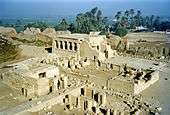 Satellite buildings of the Dendera Temple complex
Satellite buildings of the Dendera Temple complex- Entrance to the Dendera Temple complex
- Entrance gate to the temple, with bas-relief and sphinx
 Reliefs of Cleopatra VII and her son by Julius Caesar, Caesarion at the Dendera Temple
Reliefs of Cleopatra VII and her son by Julius Caesar, Caesarion at the Dendera Temple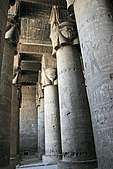 Columns of the Hypostyle Hall
Columns of the Hypostyle Hall- Ceiling of the temple before restoration (photographed 2005)
- Restored ceiling of the Temple of Hathor (photographed 2011)
- Crypt
 Kiosk of Hathor on the temple roof
Kiosk of Hathor on the temple roof.jpg) Close-up of a column on the Kiosk
Close-up of a column on the Kiosk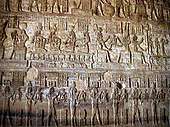 Digitally manipulated photograph of an interior wall in the Mammisi, highlighting the bas-relief
Digitally manipulated photograph of an interior wall in the Mammisi, highlighting the bas-relief
See also
- Esna temple (in Esna)
- List of Ancient Egyptian sites
References
- "Search Photos, Prints, Drawings". Library of Congress. United States Congress. Retrieved 12 September 2019.
- Kipfer, Barbara Ann (2000). Encyclopedic Dictionary of Archaeology. New York: Kluwer Academic/Plenum Publishers. p. 153. ISBN 0-306-46158-7.
- Bard, Kathryn A. (2005). Encyclopedia of the Archaeology of Ancient Egypt. Routledge. pp. 252–254. ISBN 978-1-134-66525-9.
- Bard, Kathryn A. (2015). An Introduction to the Archaeology of Ancient Egypt. John Wiley & Sons. p. 325. ISBN 978-0-470-67336-2.
- "Trajan was, in fact, quite active in Egypt. Separate scenes of Domitian and Trajan making offerings to the gods appear on reliefs on the propylon of the Temple of Hathor at Dendera. There are cartouches of Domitian and Trajan on the column shafts of the Temple of Knum at Esna, and on the exterior a frieze text mentions Domitian, Trajan, and Hadrian" Stadter, Philip A.; Stockt, L. Van der (2002). Sage and Emperor: Plutarch, Greek Intellectuals, and Roman Power in the Time of Trajan (98-117 A.D.). Leuven University Press. p. 75. ISBN 978-90-5867-239-1.
- Bard, Kathryn A. (2005). Encyclopedia of the Archaeology of Ancient Egypt. Routledge. p. 252. ISBN 978-1-134-66525-9.
- mondial, UNESCO Centre du patrimoine. "Pharaonic temples in Upper Egypt from the Ptolemaic and Roman periods - UNESCO World Heritage Centre". UNESCO Centre du patrimoine mondial (in French).
- Wilkinson, Richard H. (2000). The Temples of Ancient Egypt. Thames & Hudson. p. 149.
- Mahaffy, John Pentland (1899). A History of Egypt Under the Ptolemaic Dynasty. Methuen & Co. pp. 237 and 248.
- Mahaffy, p. 251.
- "Egypt's Most Wanted: An Antiquities Wish List". HISTORY.com. Retrieved 2018-02-24.
- "The Zodiac of Dendera". Napoleon and the Scientific Expedition to Egypt. Linda Hall Library. Archived from the original on 14 March 2009.
- Waitkus, Wolfgang (1997). Die Texte in den unteren Krypten des Hathortempels von Dendera: ihre Aussagen zur Funktion und Bedeutung dieser Räume [The texts in the lower crypts of the Hathor temples of Dendera: their statements for the function and meaning of these areas] (in German). Mainz. ISBN 3-8053-2322-0.
- Grenville, Keith. "Dendera Temple Crypt". The Egyptian Society of South Africa. Archived from the original on 25 April 2010.
- Hornung, Helmut (2000). "Fantastereien". Max Planck Forschung (in German). p. 72.
Further reading
- Jed Z. Buchwald, "Egyptian Stars under Paris Skies". pr.caltech.edu.
- R. A. Parker, "Ancient Egyptian Astronomy". Philosophical Transactions of the Royal Society of London. Series A, Mathematical and Physical Sciences, Vol. 276, No. 1257, The Place of Astronomy in the Ancient World (May 2, 1974), pp. 51–65
- Marshall Clagett, "Ancient Egyptian Science: A Source Book". Diane, 1989. ISBN 0-87169-214-7
- William Henry and Davenport Adams "Egypt Past and Present: Described and Illustrated". T. Nelson and Sons, 1885. 380 pages. Page 218 - 226
- The Dendera Reliefs, Catchpenny Mysteries.
- Frank Dörnenburg, Electric lights in Egypt?. 2004. (ed. An analysis of how the Egyptians didn't have electricity).
- Mariette, Auguste, Dendérah, Bookshop A. Franck, Paris, 1875.
- Fischer, H.G., Dendera in the third millennium B.C. down to the theban domination of upper Egypt, J.J. Augustin publisher, New York, 1968.
External links
| Wikimedia Commons has media related to Dendera Temple complex. |
- Dendera Temple complex. satellite-sightseer.com.
- Dendera (French)
- High-resolution Images of Dendera Temple Ceiling



